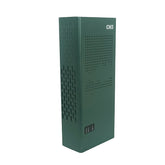Ship-tracking microsatellites could detect GPS jammers from space
A satellite company now offering ship monitoring and tracking is investigating whether it can use its new formation flying satellites to locate GPS jammers and potential interference.
Virginia-based HawkEye 360 has flown three microsatellites in sun-synchronous polar orbit since early 2019. The Hawk satellites can detect radio frequency transmissions from the Earth's surface and, working as a coordinated cluster, independently determine source location. They are currently used to detect transmissions from Automatic Identification System (AIS) devices that vessels are required to carry and independently geolocate the source so that the reported and actual location of the vessel can be compared and reported. The system can locate a transmitter with an accuracy of 500 meters depending on the signal. This could improve as HawkEye builds its constellation.
The company has already committed to putting five more clusters in space by the end of 2021, and HawkEye CEO John Serafini told Inside GNSS there are plans to launch an additional cluster of by mid 2022. Funding is underway for additional satellites through a Series B funding round completed earlier this year. With seven groups of satellites in orbit, the return rate - that is, the frequency with which a satellite will fly over the same place on Earth - will increase from about once every five hours to once every 30 minutes. around,” Serafini said.
Each group of satellites flies in formation, a capability made possible by a specially designed propulsion system. Their software defined radios are capable of tuning frequencies ranging from 144 MHz to 15 GHz (approximately VHF to Ku band). To be detected from space, the signal strength on the ground must be 1 watt or more.
“Generally speaking, if the signal is greater than one watt of power — between 150 MHz and 15 GHz — we can detect it and we can geolocate, process and analyze that signal,” Serafini said. During the first 14 months of operation, Cluster 1 detected 11 million independent geolocations of various signals.

All of these abilities come in nice little packages. The first three satellites weigh only 15 kg each. Starting with Cluster 2 which will increase to 25 to 28 kg each.
The market initially targeted by the company was oriented towards services for defence, intelligence and security applications. HawkEye is now evaluating offering a new service that would identify the location of GPS jammers.
“GPS jamming is part of our product roadmap,” Serafini said, and the company expects to be able to offer the service in about six months. “We need to assess the opportunity and develop a product.”
It's entirely plausible that HawkEye satellites could locate GPS jammer, according to Logan Scott of LS Consulting, an expert in navigation and telecommunications signals. Scott said he was introduced to the technology a few years ago during a presentation and, although he hasn't done any link analysis, thinks it has potential for such a capability. . "If it's a big jammer. Yeah, I could definitely see something like that - there's some cool stuff you can do.













